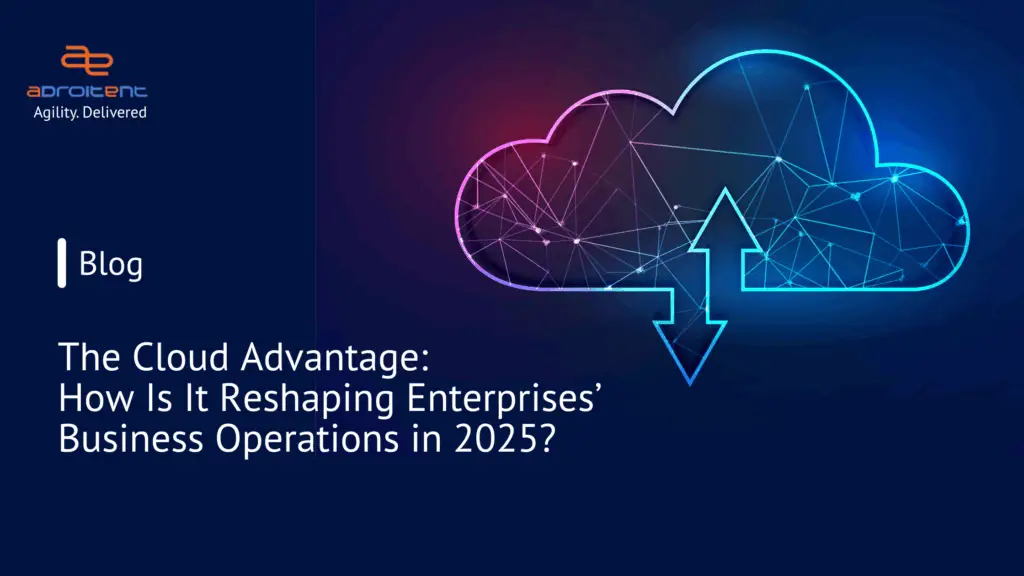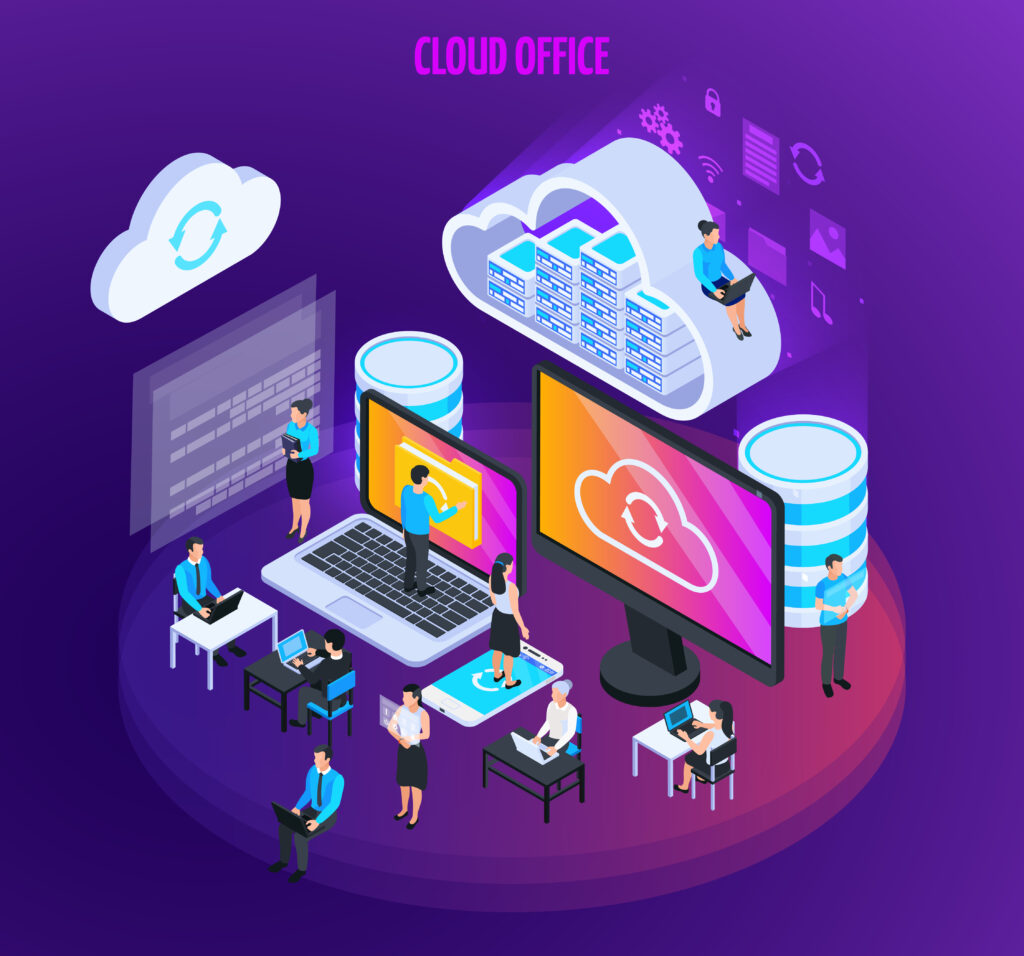
Table of Contents
Introduction
In 2025, cloud computing is no longer seen as a mere technological shift but has become the cornerstone of digital transformation for enterprises. Cloud computing is a key enabler of digital transformation, allowing organizations to modernize operations, accelerate innovation, and scale with ease. It offers the infrastructure, platforms, and services essential for enhancing and optimizing business processes. By adopting cloud solutions, enterprises can streamline operations, increase agility, and significantly reduce costs. Various cloud service models are available, each offering unique capabilities that help reshape and improve how businesses function.
What are the different types of Cloud Computing Models?

Infrastructure as a Service (IaaS): This model provides virtualized computing resources on-demand such as servers, storage, and networking. It allows businesses to scale their infrastructure on demand on a pay-as-you-go basis that is cost-effective. Businesses can maintain access to data and applications during outages or disasters, while also having the flexibility to scale computing resources up or down based on demand.
Platform as a Service (PaaS): This is an effective cloud computing model that allows development teams to build, test, deploy, and scale applications without managing the underlying infrastructure. This model streamlines application development and deployment and is considered cost-effective. In this model, a third-party provider delivers hardware and software tools to businesses.
Software as a Service (SaaS): This is a cloud-based model that allows users to access applications over the internet with a subscription-based services model. In this method, customers pay to access and use cloud-hosted software over the internet rather than purchasing it that ensures cost effective for businesses.
What is the Cloud Advantage for digital enterprises in 2025
Let us know some of the important cloud advantages for enterprises and what leading research analyst say:
- According to Gartner projections, the end-user cloud spending is set to increase 21.5% globally to $723 billion in 2025. The cloud market will reach nearly $600 billion in 2025, the analyst firm said. Gartner expects 90% of organizations to have hybrid cloud deployments by 2027. Gartner predicts that 90% of organizations will adopt a hybrid cloud approach through 2027, and the most urgent GenAIchallenge necessary to address over the next year will be data synchronization across the hybrid cloud environment.”
- According to a Statista report, “The worldwide public cloud computiang market continues to grow and is expected to reach an estimated 723.42 billion U.S. dollars in 2025. This encompasses business processes, platform, infrastructure, software, management, security, and advertising services delivered by public cloud services.”
- According to another latest 2025 CIODIVE report, Cloud-based applications and software services continue to be the largest spending segment in their analysis report. Spending on SaaS applications will approach $300 billion in 2025, up from just over $250 billion in 2024. Infrastructure and platform services, the second and third largest segments, are the fastest-growing markets with expected year-over-year spending increases of 25% and 22% respectively. These latest reports showcase the increasing cloud adoption and the related cloud advantage for enterprises.
Now, let us know the important cloud benefits for enterprises.

- Faster deployments: Cloud-native applications can be deployed and updated faster than on-premise solutions.
- Collaboration and communication: Cloud-based collaboration tools facilitate seamless communication and teamwork, regardless of location.
- Automation and cost optimization: Cloud-based technologies enable the automation of repetitive tasks, enabling optimization of business processes and reducing overall costs.
- Faster innovation: Cloud platforms provide access to cutting-edge technologies, such as AI and machine learning, which help accelerate enterprises’ innovation.
- Real-time analytics: Edge computing helps enterprises to process data closer to users, reducing latency and improving the real-time analytics.
- Advanced security: Cloud providers invest heavily in security and many cloud solutions offer advanced security features and compliance. Cloud storage protects against data breaches, ransomware, and cyber threats.
- Optimized IT spending: Reduces the overall IT overhead with less manual effort needed for server and infrastructure management. This reduction in IT overhead results in optimized IT spending.
- Data-driven decision-making: Various Cloud-based analytics and AI tools provide businesses with deeper insights into their data, leading to more informed decisions.
- Improves business agility: The Cloud provides on-demand scaling that enables businesses to either increase or decrease IT resources need-based which improves business agility.
According to leading analysts, as today’s enterprises modernize data operations and adopt cloud-based GenAI tools, hybrid cloud ecosystems that integrate on-premise systems with infrastructure are bound to grow in the forthcoming years. Thus, Cloud platforms enable businesses to quickly adapt to changing market conditions and scale their business operations accelerating digital transformation.
How Cloud is Reshaping Digital Enterprises in 2025
Digital enterprises typically imply enterprises and businesses that heavily rely on technology and data, which makes the cloud’s influence critically profound for them.
According to a leading global technology market analyst firm with a distinct channel focus it said, its cloud services spending report states that cloud spending to grow 19% in 2025. Amazon Web Services (AWS) maintained its leadership position in the global cloud market in Q4 2024, securing a 33% market share and achieving 19% year-on-year revenue growth. Microsoft Azure remained the second-largest cloud provider in Q4 2024, with a 20% share and impressive annual growth of 31%. Microsoft reported that Azure’s growth included a 13% contribution from AI services, which grew 157% year on year. Google Cloud, the third largest cloud provider, retained an 11% market share and reported strong 32% year-on-year growth. As of 31 December 2024, Google Cloud’s revenue backlog grew to US$93.2 billion, up from US$86.8 billion in Q3.
According to the latest update to the International Data Corporation (IDC) Worldwide Software and Public Cloud Services Spending Guide, “Worldwide spending on public cloud services is forecast to reach $805 billion in 2024 and double in size by 2028.” “Cloud now dominates tech spending across infrastructure, platforms, and applications,” said Eileen Smith, group vice president, Data & Analytics at IDC. “Most organizations have adopted the public cloud as a cost-effective platform for hosting enterprise applications and for developing and deploying customer-facing solutions. Looking forward, the cloud model remains incredibly well positioned to serve customer needs for innovation in application development and deployment, including as data, artificial intelligence/machine learning (AI/ML), and edge needs continue to define the forefront of cloud innovation.”
Pointers showing how cloud is reshaping digital enterprises:
- On-demand scaling: On-demand scaling is a key advantage of cloud computing that allows businesses to automatically adjust IT resources. This capability helps enterprises optimize costs, improve performance, and enhance agility, making it an essential strategy for modern digital businesses. It further helps enabling cost efficiency and optimizing resources.
- Hybrid & multi-cloud strategies: Adopting various hybrid and multi-cloud strategies helps enterprises to avoid vendor lock-in and optimize enterprises’ business performance.
- Automated workflows: Cloud computing plays a crucial role in automating workflows, helping businesses enhance efficiency, accuracy, and scalability. By leveraging AI, machine learning, and serverless computing, enterprises can eliminate manual processes, optimize resources, and accelerate digital transformation. Further, AI-powered cloud solutions help automate customer support, marketing personalization, fraud detection, and supply chain optimization. Cloud platforms like AWS Step Functions, Azure Logic Apps, and Google Cloud Workflows automate multi-step business processes. Cloud holds as a base for business operations in 2025 across the sectors of Supply chain management, Customer relationship management (CRM), Data analytics and business intelligence (BI), Collaboration and communication, Cybersecurity, etc.
- Faster AI model training: Cloud-based GPUs and TPUs accelerate AI model development for real-time insights. Machine learning models in the cloud help enterprises make data-driven decisions in real time. Financial institutions use AI-driven fraud detection in cloud environments to prevent cyber threats.
- 5G-powered cloud networks: These 5G-powered cloud networks enhance IoT applications in healthcare, smart cities, and logistics. A very good example is the Smart factories leveraging edge AI in the cloud for predictive maintenance.
- Global reach: Enterprises can deploy applications across multiple regions effortlessly with cloud enabling data access availability anytime and anywhere. The Virtual desktop infrastructure (VDI) ensures secure access to enterprise systems from anywhere. The Cloud-based collaboration tools such as Microsoft 365, Google Workspace, Zoom, etc. power remote and hybrid work environments help improve enterprises’ business operations.
How Cloud is Reshaping Digital Enterprises in 2025
With the growing importance of cloud adoption for digital enterprises, below are listed various cloud solutions for businesses to analyse and understand.
Multi-Cloud Solutions: This multi-cloud solution is a mix of public, private, and on-premise cloud environments that help to optimize enterprises’ performance and security. Some of the key benefits in this method are that; eliminates vendor lock-in by using AWS, Azure, and GCP together. Further, it also improves disaster recovery, data availability, and enhances
performance by distributing workloads. An effective example of a combination of all clouds: Enterprises use AWS for AI, Azure for DevOps, and Google Cloud for data analytics in a multi-cloud strategy model.
AI and ML-powered Cloud Solutions: In 2025, AI-driven cloud platforms are evolving and will be most sought after as they enable automation, better decision-making with predictive analytics. Some of the key benefits of this cloud solution are; enhances real-time insights, enables effective forecasting with AI analytics, and automates repetitive tasks with AI-driven process automation.
It also improves customer engagement with AI-powered chatbots. A good example of this cloud solution: AI cloud solutions like Google Vertex AI, AWS SageMaker, and Microsoft Azure AI help enterprises deploy smart applications quickly and efficiently.
Serverless Computing Solutions: This is a specific cloud solution wherein without managing infrastructure, the data processing to users occurs through edge devices. Serverless computing, is a cloud computing model that allows developers to build and run applications without managing the underlying infrastructure. Some of its key benefits are; reduces operational costs with pay only for resources option and also improves latency by processing data closer to users. It can be best used for IoT and real-time data processing.
Edge Computing Solutions: As more and more data is available in 2025, edge computing is said to dominate as it reduces latency and improves cloud-based performance significantly.
Conclusion
Enterprises and businesses across all industries should adopt cloud solutions to enhance agility, security, and scalability. With AI-driven automation, multi-cloud strategies, and edge computing, cloud technology is transforming how enterprises operate their businesses, improving their operational efficiency.
Undoubtedly, cloud solutions are reshaping enterprises’ business operations by improving business efficiency with automation. The cloud advantage in 2025 extends far beyond cost savings and is making cloud adoption indispensable for enterprises to stay ahead in an increasingly digital-first world. For businesses to take the complete benefits of cloud adoption with proper cloud strategies kept in place, should leverage the services of cloud solution partner.
Adroitent’s Cloud Capabilities
Adroitent’s cloud services encompass a comprehensive range of solutions designed to accelerate enterprises’ digital transformation and optimize their business operations. At Adroitent, we have adopted the Agile Manifesto for all cloud projects, from single-cloud to multi-cloud environments leveraging automation and analytics to meet customers’ business requirements.
We provide innovative cloud solutions using the latest digital technologies, models, processes, and tools. Our growing network of cloud technology experts effectively handles the most complex cloud solution and migration challenges and enables secure and scalable cloud solutions. We have established the Cloud Center of Excellence (CCoE) to ensure seamless cloud services to global customers.
Our range of Cloud Services
- Site Reliability Engineering
- Cloud Architecture and Transformation
- Cloud Optimization and Migration Services
- Cybersecurity
- Cloud Integration Solutions
Why Choose Adroitent for your Cloud Solutions
With 19+ years of expertise in IT and AI-driven solutions, Adroitent provides comprehensive cloud services designed to help enterprises accelerate digital transformation, enhance scalability, and optimize IT costs. Our cloud solutions are tailored to meet industry-specific needs, ensuring security, compliance, and operational efficiency.
- Experienced professional teams: Our experienced multi-disciplinary team of 500+ associates working on projects across industries of Healthcare, BFSI, Telecom, etc. Our talented pool of resources across tech stacks of Microsoft, Java, Cloud, RPA, CMS, BI, Data Analytics, etc. helps to deliver scalable, robust, and high-quality solutions.
- Customization and tailored solutions: We understand each business is unique, and tailor a range of IT services and AI solutions to meet the individual requirements of customers.
- Effective engagement model: AgileSourcing is the way we get engaged with our customers. This engagement model is a seamless integration of people, processes, and tools and ensures that we deliver tailored, high-quality solutions to customers. Our AgileSourcing encompasses four customer-centric engagement methods that include Managed Resourcing, Project Outsourcing, Shared Services, and Competence-driven Technology/Practice Center.
- Expertise in multi-cloud & hybrid deployments: Proven success in AWS, Azure, Google Cloud, and private cloud solutions.
- AI & Automation-driven cloud optimization: Leverages AI-powered analytics to reduce costs and improve efficiency.
- Secure & compliant cloud frameworks: Ensures data protection, threat mitigation, and compliance with global regulations.
- Scalable & future-ready cloud solutions: Enables businesses to scale effortlessly while ensuring high performance.
- Industry-specific cloud capabilities: Tailored cloud solutions afor healthcare, finance, retail, and manufacturing enterprises.


